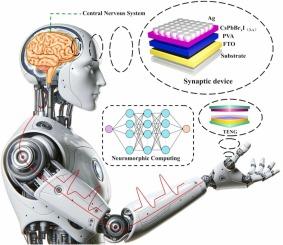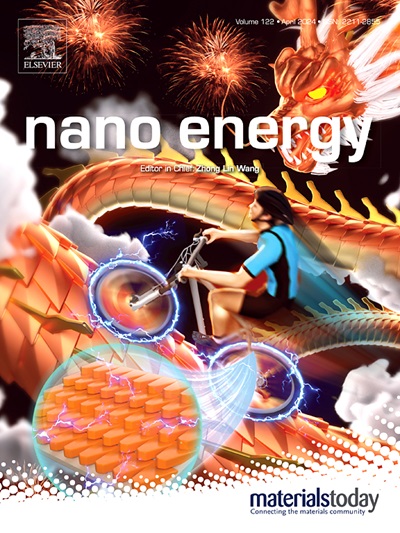基于全无机过氧化物的人工突触设备,用于自我优化的神经形态计算
IF 16.8
1区 材料科学
Q1 CHEMISTRY, PHYSICAL
引用次数: 0
摘要
能够模仿生理突触行为的人工突触在智能机器人领域受到广泛关注。然而,人工突触如何实现模仿生物行为的自优化反馈是一个极大的挑战。本文通过耦合基于 CsPbBrxI(3-x)的人工突触装置和三电纳米发电机(TENG),开发了一种新型自供电人工神经通路(SANP),实现了自我优化的神经形态计算。TENG 可将外部机械刺激转化为电能,这不仅是为 SANP 供电的电源,也是向神经形态计算的突触设备传输电刺激的电源。电刺激可以很好地调节突触装置的电导,从而调整 Ag 与 CsPbBrxI(3-x)之间的肖特基势垒高度,模拟突触可塑性的调节。同时,该突触装置还能实现学习和记忆的突触功能。此外,SANP 作为自供电的机械痛觉感受器,可成功模拟痛觉感受器的 "阈值"、"松弛 "和 "异动 "特征。更重要的是,在反复的机械刺激下,具有突触自我优化反馈功能的 SANP 可同时进行学习和记忆训练以及机械臂的抓取和伸展。因此,SANP 可以在没有外部电源的情况下有效地完成信号传输、处理和学习任务,在神经形态计算和智能机器人领域具有潜在的应用前景。本文章由计算机程序翻译,如有差异,请以英文原文为准。

All inorganic perovskite-based artificial synaptic device for self-optimized neuromorphic computing
Artificial synapse that can mimic physiological synaptic behaviors has attracted extensive attentions in intelligent robots. However, it is an extreme challenge for artificial synapses to achieve self-optimized feedback of mimicking biological behavior. Herein, a novel self-powered artificial neural pathway (SANP) is developed by coupling CsPbBrxI(3-x)-based artificial synaptic device and triboelectric nanogenerator (TENG) for self-optimized neuromorphic computing. The TENG can convert external mechanical stimulation into electricity that acts not only as a supply source to power the SANP but also as electrical stimulation to transmit to the synaptic device for neuromorphic computing. The synaptic device’s conductance can be well modulated by the electrical stimulation, which tunes the height of Schottky barrier between Ag and CsPbBrxI(3-x), to simulate the regulation of synaptic plasticity. Simultaneously, the synaptic device can implement synaptic functions of learning and memory. Furthermore, the SANP as self-powered mechano-nociceptor can successfully mimic the nociceptor features of “threshold”, “relaxation” and “allodynia”. More importantly, under repeated mechanical stimulation, the SANP with synaptic self-optimized feedback features enables the learning and memory training and the robotic arm’s grabbing and spreading simultaneously. Consequently, the SANP can effectively accomplish signal transmission, processing, and learning tasks without external power supply, which demonstrates potential application in neuromorphic computing and intelligent robots.
求助全文
通过发布文献求助,成功后即可免费获取论文全文。
去求助
来源期刊

Nano Energy
CHEMISTRY, PHYSICAL-NANOSCIENCE & NANOTECHNOLOGY
CiteScore
30.30
自引率
7.40%
发文量
1207
审稿时长
23 days
期刊介绍:
Nano Energy is a multidisciplinary, rapid-publication forum of original peer-reviewed contributions on the science and engineering of nanomaterials and nanodevices used in all forms of energy harvesting, conversion, storage, utilization and policy. Through its mixture of articles, reviews, communications, research news, and information on key developments, Nano Energy provides a comprehensive coverage of this exciting and dynamic field which joins nanoscience and nanotechnology with energy science. The journal is relevant to all those who are interested in nanomaterials solutions to the energy problem.
Nano Energy publishes original experimental and theoretical research on all aspects of energy-related research which utilizes nanomaterials and nanotechnology. Manuscripts of four types are considered: review articles which inform readers of the latest research and advances in energy science; rapid communications which feature exciting research breakthroughs in the field; full-length articles which report comprehensive research developments; and news and opinions which comment on topical issues or express views on the developments in related fields.
 求助内容:
求助内容: 应助结果提醒方式:
应助结果提醒方式:


